Europe Looks East – Part I
Europe Looks East – Part I
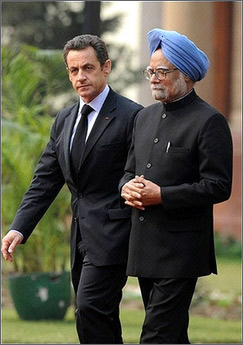
BRUSSELS: French president Nicolas Sarkozy flew to India to take the seat as principal foreign guest at the country’s Republic Day pageantry on January 26. It was more than an opportunity to soak in the sun amidst a burst of colors. It was a sign that after years of fascination with China, European Union governments are waking up to India’s economic potential and growing global clout. Following in the footsteps of their US counterparts, European leaders and businesses beat a path to Delhi in search of new opportunities - and to woo Indian companies seeking to invest in the EU.
The Sarkozy visit follows a November 2007 summit held in the Indian capital, at which leaders from both sides vowed to clinch a free-trade agreement by the end of 2008, tackle climate change and strengthen an ambitious “strategic partnership” pact signed in 2004.
Transforming the upbeat rhetoric in Delhi into a robust and effective EU-India relationship will take time, effort and persistence.
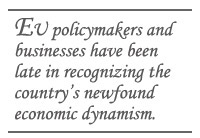
For one, both sides must make up for years of mutual neglect. Used to viewing India as a plodding economic elephant and mesmerized by the stronger lure of China, EU policymakers and businesses have been late in recognizing the country’s newfound economic dynamism, including the success of the Indian information-technology sector, the rise of India’s computer-services outsourcing industry and the emergence of Indian world-class industrial giants, eager to scour Europe for markets and acquisitions. EU investments in the country totaled a modest €1.6 billion in 2006, compared to €3.7 billion in China.
Admiration for India’s economic performance and dynamic new entrepreneurs such as Tata, whose $12 billion acquisition of Anglo-Dutch steelmaker Corus hit headlines across the 27-nation bloc in early 2007, is tainted, however, by anti-globalization sentiments across the EU. Although the debate on outsourcing has been less fierce in Europe than in the US, a majority of Europeans fear the rise of India – and even more of China – as a threat to European jobs and wages rather than an opportunity for expanded business.
In Delhi, policymakers are trying to bring EU-India ties out of the shadow cast by their growing relationship with the US. Successive EU enlargements, the EU’s growing reputation as a global defense and security actor as well as continued strong EU economic performance are key reasons for India’s increased interest in Europe.
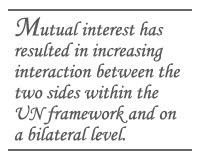
Mutual interest has resulted in increasing interaction between the two sides within the United Nations framework and on a bilateral level. Ties have strengthened since the first EU-India Summit in Lisbon in 2000, with cooperation on political, geopolitical and multilateral issues as well as economic and trade ones. Significantly, India has shed earlier inhibitions about engaging in dialogue with the EU on developments in Nepal, Sri Lanka and Bangladesh.
Still, both sides struggle to give substance to their strategic partnership and have different views on what this means in practice.
The EU’s first-ever Security Strategy published in December 2003, identified India – along with the US, Russia, Japan, China and Canada – as a country with which the Union should seek to develop a strategic partnership to build an “effective multilateral system leading to a fairer, safer and more united world.” The EU wants to use its strategic partnerships to share global responsibilities and meet 21st century challenges, including terrorism, proliferation of weapons of mass destruction, state failure and regional conflicts.
As an emerging power, India’s immediate concerns are understandably very different from those of the EU and its member states. As it aspires to play a more forceful global role, as illustrated by its demand for a seat on the UN Security Council and participation in international peacekeeping operations, India views a strategic partnership with the EU and the US as a vehicle for ensuring greater worldwide prestige and political clout.
While developing a strategic partnership with the EU is a goal, Delhi’s primary focus, however, is on its troubled neighborhood. Rivalry with China and tensions with Pakistan as well as political turmoil in Bangladesh, Nepal and Sri Lanka dominate the country’s foreign-policy agenda.
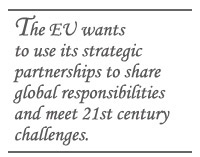
Not surprisingly, there is a significant mismatch of aspirations. The EU has made no secret of its disappointment at India’s failure to stand up for democracy and human rights during Burma’s recent military crackdown on dissidents. EU policymakers have argued that as the world’s largest democracy – and given its growing economic ties with Burma – India must use its considerable leverage to put pressure on the military junta in Rangoon. India has responded that it does not believe that sanctions work.
The EU-Indian strategic partnership has failed to soften India’s tough line in the World Trade Organization’s Doha trade talks, where Delhi continues to resist US and EU demands for further cuts in industrial tariffs. India has refused to accept Western calls for stricter binding commitments to reduce greenhouse-gas emissions to combat climate change, arguing that a developing country cannot be expected to slow the pace of industrialization.
Differences also emerged on the US-India nuclear agreement, which – if it enters into force – will give energy-hungry India access to US civil nuclear technology. The EU has no common position on the deal. Sarkozy used his visit to India to sign a framework accord paving the way for nuclear-power cooperation, including the supply of reactors, once Delhi clears hurdles with the UN's nuclear watchdog and the 45-member Nuclear Suppliers Group. However, other EU states fear that India could use imported nuclear fuel to feed its civilian energy program while diverting its own nuclear fuel to weapons production.
Despite such divergences, however, India and the EU cooperate in many sectors and Delhi views Europe as an important source of high technology. In addition, negotiations on a first-ever EU-India free-trade agreement were launched in June 2007, with India hoping the accord will be ready for implementation later this year. Discussions focus on slashing tariffs on trade in manufactured goods, removing non-tariff barriers as well as liberalizing trade in services, easing investment flows and trade facilitation.
Trade between the EU and India currently has grown from €4.4 billion in 1980 to over €46 billion in 2006, but still accounts for only 1.8 percent of total EU trade.
While ties are improving, building a sustainable EU-India partnership requires further action on a number of fronts, including increased contacts between policymakers, think tanks and the media. For many Indians, the focus remains on the EU as an economic rather than a political partner.
The EU meanwhile must ensure a better balance between its aid programs geared to meet India’s development needs and more modern EU aid instruments aimed at encouraging economic reforms and modernization, ensuring regulatory cooperation and joint projects in the renewable-energy sector.
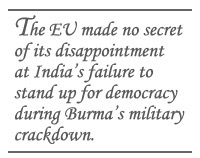
The road ahead will not be easy. The EU is not in a position at the moment to respond positively to India’s demands for nuclear cooperation, more decision-making rights in the Galileo project or increased security cooperation. India, for its part, will not accept the EU stance on climate change, the Doha round or demands that it take on more responsibility for resolving regional hotspots like Burma.
Such differences, however, need not become an insurmountable obstacle to a closer relationship. Political will, combined with steady, practical steps leading to more cooperation, will be crucial in forging a real EU-India strategic partnership.
Shada Islam is a senior program executive at the European Policy Centre. She writes for YaleGlobal Online in a personal capacity.